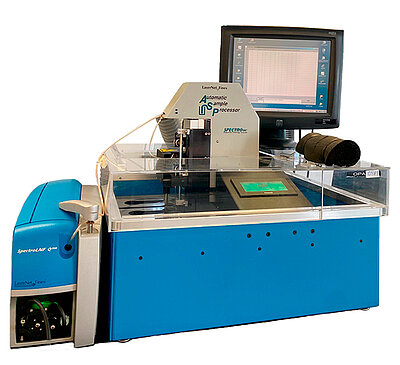
| OELCHECK test instrument: | Spectro Laser Net Fines-C |
| Sample quantity: | 30 ml |
| Unit: | number of particles per 100 ml |
| Test result: | number of particles per 100 ml cleanliness class according to ISO particle count and size according to ISO number of particles in various categories outline figures and particle structures |
| Analysis for: | gear oils, occasionally for hydraulic and circulating oils |
| Brief description: | The homogenised sample is pumped at a constant speed through a viewing window (flow cell) lit by a very bright laser beam. The laser beam shows the shapes of the particles recorded. These are magnified with a lens in such a way that they can be recorded by a high-speed CCD camera and stored as black-and-white photos. The shape and size of the particles is also analysed and assigned to specific categories such as wear fatigue, cutting wear, non-metal impurities (tribopolymers), water droplets and so on. The number and size of particles can also be recorded, as during the particle counting process. |
| Statement: | Alongside a classic particle count, an optical particle analysis is also used to make a photographic record of the individual particles in the oil flow. They are also listed and commented upon on three additional pages in the lab report. The procedure supplements the AES and PQ index test methods, which only show particles < 5 µm or rather magnetisable particles, and the particle count, which does not differentiate between "hard" and "soft" particles. |
| Underlying test standard: | ISO 4406, ASTM D7596 |